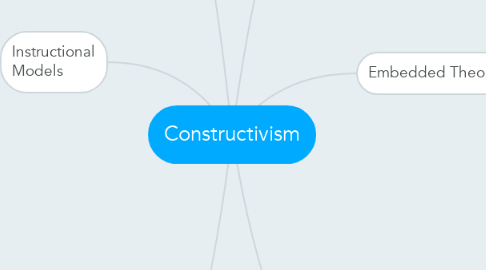
1. Basic Principles
1.1. Learners construct their own knowledge
1.2. Learning occurs through interaction and collaboration
1.3. Knowledge cannot be injected
1.4. Active learning
1.5. There are multiple perspectives about the way the world works
2. Embedded Theories
2.1. Social-Cultural Learning Theory
2.1.1. Culture: developed through using tools and symbols
2.1.2. Symbols are what separate humans from animals
2.1.3. The Central Role of Language: language is possible because of the tools and symbols belonging to cultures.
2.1.4. Three Stages of Speech: (1) social special (external speech), (2) egocentric (when children think out loud), and (3) inner speech (soundless speech that directs thinking and behavior)
2.1.5. The Zone of Proximal Development: the gap between a child's potential development and their actual development
3. Principal Theorists
3.1. Lev Vgotsky
3.1.1. Wanted to include consciousness into the Psychology field
3.1.2. A study of the mind would be a major distinguisher between humans and other animals
3.1.3. Social/Language development was the determining factor of a child's psychological development
3.2. Jean Piaget
3.2.1. Children think entirely differently from adults
3.2.2. In grade school, he wrote a short piece on the albino sparrow which is seen as the start to a great scientific career
3.2.3. We start out with very simple thought processes and they become more complex as we grow up
4. Goals of Instruction
4.1. Build relationships with the world and the environment through interaction
4.2. Learning is made up of constructing your own learning, not just instruction
4.3. Focus on the process, not the product
5. Instructional Models
5.1. Authentic Learning
5.1.1. Learners should be presented with realistic and everyday problems
5.1.2. Instruction should include problems that are ill-structured and complex, to help in the real world
5.1.3. Collaborative activities with peers
5.2. Collaborative Learning
5.2.1. Students work in groups to solve problems and achieve goals
5.2.2. Demonstrates distributive intelligence, sharing your knowledge with peers through collaboration
5.2.3. Students can understand POVs outside of their own
5.3. Case-Based Learning
5.3.1. Use case studies to present students with a realistic situation to respond to and solve a problem
5.3.2. Good for situations with more than one solution
5.3.3. Allow learners to use more strategies and skills in order to solve the problem

